Embarking on Peter Davison’s tenure as The 5th Doctor was an experience filled with anticipation and a touch of apprehension. After immersing myself in the long and beloved era of Tom Baker’s Fourth Doctor, complete with the iconic scarves and bohemian charm, the shift to a new Doctor felt significant. Tom Baker’s portrayal had become synonymous with “Doctor” in my mind, setting a high bar for any successor. The question loomed: what would this new chapter of Doctor Who bring? My journey into the Fifth Doctor’s era, spanning Seasons 19-21 from 1982 to 1984, proved to be anything but disappointing.
My initial anxiety about embracing the 5th Doctor quickly transformed into empathy and excitement. If I felt a sense of transition after two years of the Fourth Doctor, how must Peter Davison have felt stepping into the role after Tom Baker’s remarkable seven-year run? This realization sparked a surge of admiration for Davison. He was the actor with the courage to become the Doctor after Tom Baker. This thought ignited my enthusiasm, and I eagerly began watching the Fifth Doctor’s episodes from June 17, 2024, to June 24, 2024, concluding his final serial with a deep appreciation for his unique contribution to the Doctor Who legacy.
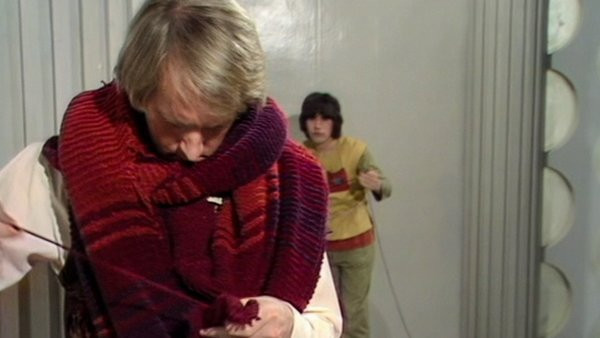 Freshly regenerated, the Doctor begins unraveling his old scarf while Adric follows him through the TARDIS to make sure he’s okay.
Freshly regenerated, the Doctor begins unraveling his old scarf while Adric follows him through the TARDIS to make sure he’s okay.
The Fifth Doctor, newly regenerated and discarding remnants of his past incarnation, is observed by Adric in the TARDIS.
A Bold Departure: Setting the Stage for the 5th Doctor
Peter Davison’s debut episode, “Castrovalva: Part One,” definitively signaled the end of the Tom Baker era. The regeneration was depicted as physically taxing, and the Fifth Doctor’s search for the Zero Room, a sanctuary for healing within the TARDIS, was visually symbolic. He literally unwound his iconic scarf, using it as a trail to navigate back to the console room. This act was more than practical; it was a powerful visual cue. For seven years, the scarf had been an inseparable part of the Fourth Doctor’s identity. Its removal, followed by discarding shoes, coat, and even tearing his vest, sent a clear message: this was a radical transformation. A new Doctor, and a new era, had definitively begun.
Preppy Doctor, Fresh Style: The Fifth Doctor’s Look
Adjusting to the Fifth Doctor’s distinctly “preppy” aesthetic took a moment. The Fourth Doctor, the epitome of a bohemian wanderer with his wild hair, flowing scarf, and wide-brimmed hat, was succeeded by a Doctor in sneakers, slacks, a pullover sweater over a button-down shirt, and a cricket-inspired coat. While undeniably preppy, this was still the Doctor, complete with a sprig of celery on his lapel, a quirky touch that maintained his eccentricity. This stylistic shift, however, reinforced the break from the previous era and was, in its own way, quite refreshing.
An interesting detail emerged in the credits of the first and subsequent episodes of Season 19: Peter Davison’s character was credited as “The Doctor,” not “Doctor Who.” This was a first in classic Doctor Who, a subtle but notable change in presentation.
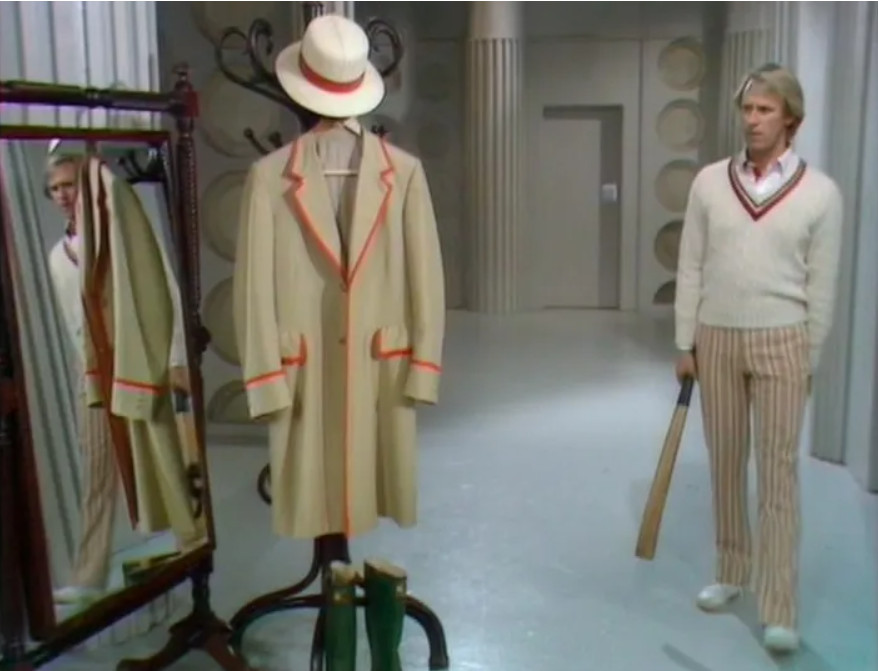 With cricket bat in hand, the Doctor wanders the TARDIS pulling together his new look.
With cricket bat in hand, the Doctor wanders the TARDIS pulling together his new look.
The Fifth Doctor, exploring his new identity, refines his look within the TARDIS, cricket bat in hand.
The TARDIS Family Dynamic: A Sitcom in Space
The Fifth Doctor continued traveling with Adric, Nyssa, and Tegan, companions who had joined the Fourth Doctor’s adventures. Their dynamic took on a charmingly unique flavor, best described as an ’80s sitcom premise: a young, hip, single dad navigating parenthood. And it worked wonderfully! Nyssa and Tegan even shared living quarters on the TARDIS, enhancing the familial atmosphere.
Tegan embodied the sassy, sarcastic older daughter, famously describing herself as “just a mouth on legs.” Her witty banter and exasperated reactions to the Doctor’s sometimes chaotic plans provided comedic relief and a relatable grounding force. In contrast, Nyssa played the role of the “perfect” middle daughter, consistently striving for harmony within their unconventional family unit, even while still navigating her own youth and experiences. Adric, the youngest brother, was portrayed as the one often doted upon by the Doctor, yet simultaneously grappling with insecurities and a yearning for more maturity and recognition.
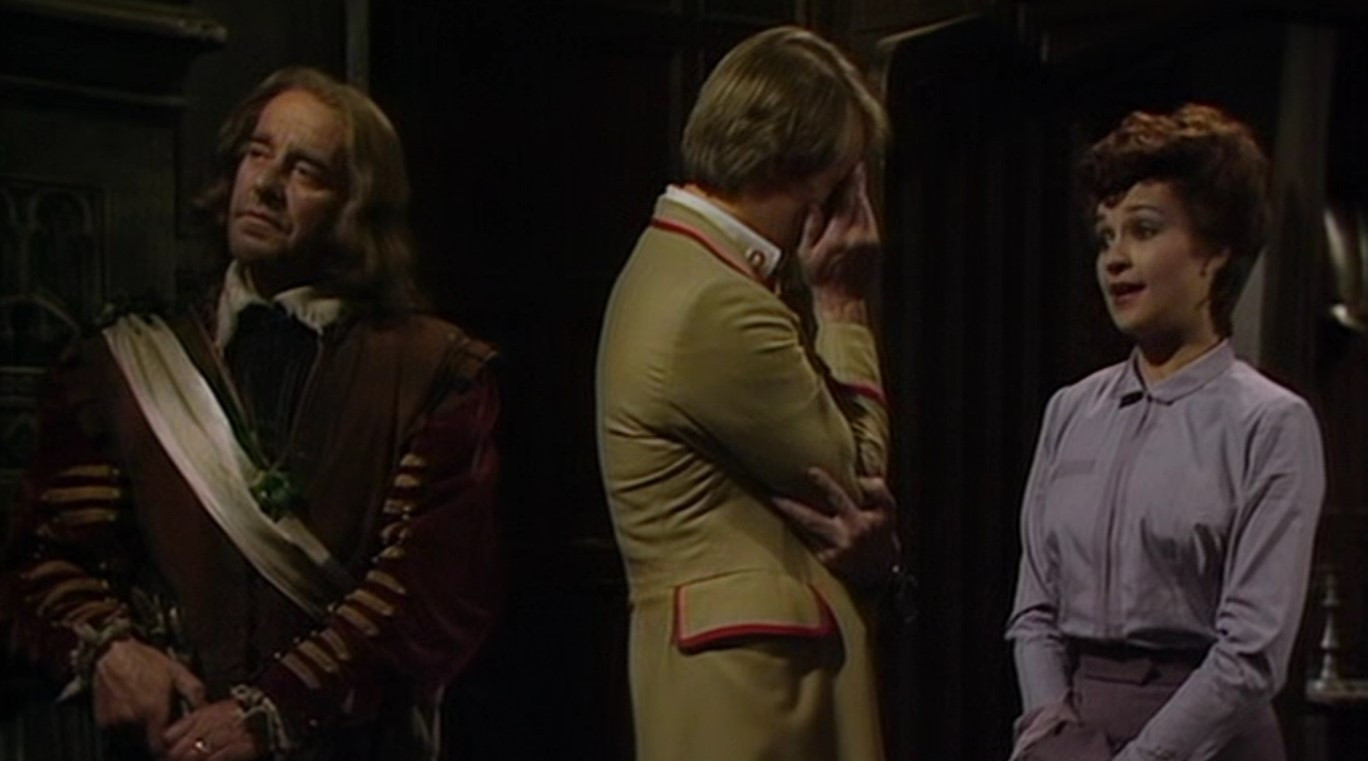 Tegan leaves the Doctor exasperated XD.
Tegan leaves the Doctor exasperated XD.
Tegan’s sharp wit often leaves the Fifth Doctor in a state of humorous exasperation.
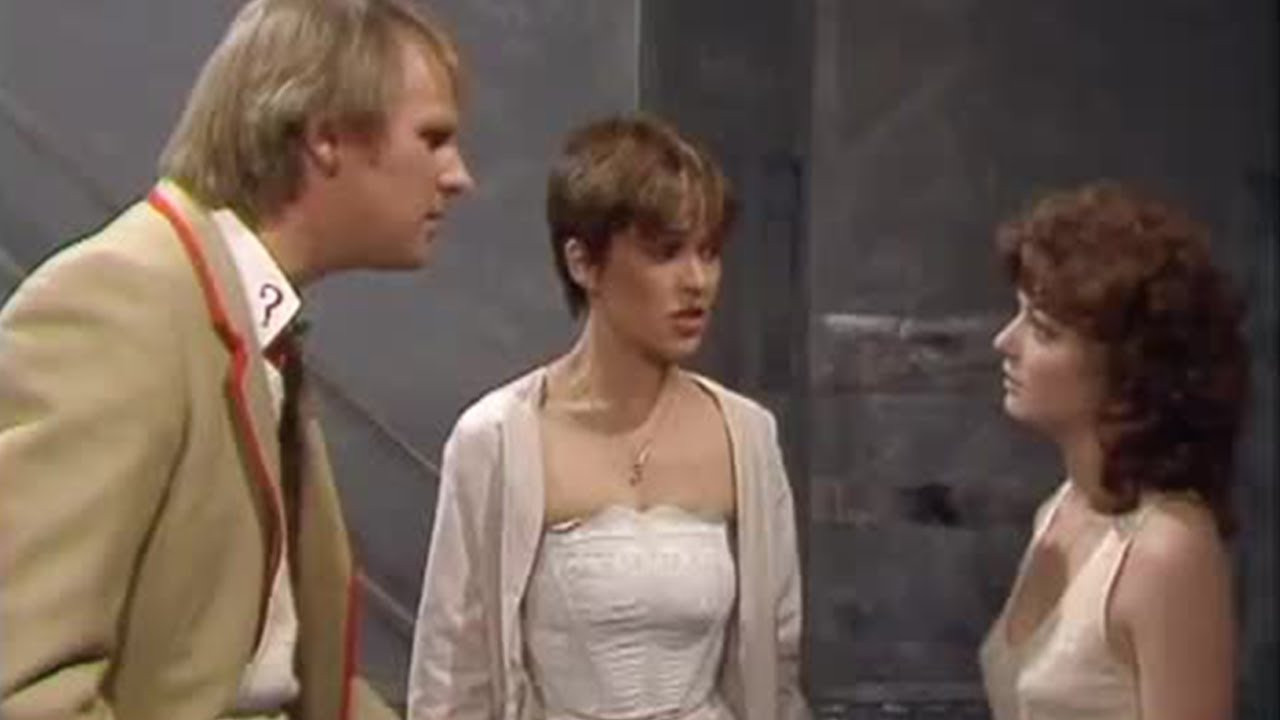 Nyssa does her best to create harmony between the Doctor and Tegan.
Nyssa does her best to create harmony between the Doctor and Tegan.
Nyssa acts as a peacemaker, mediating interactions between the Doctor and Tegan.
 The Doctor tries to talk to Adric in his room and just gets alllllllll sorts of teenage angst.
The Doctor tries to talk to Adric in his room and just gets alllllllll sorts of teenage angst.
The Doctor encounters teenage angst as he attempts to engage with Adric in the TARDIS.
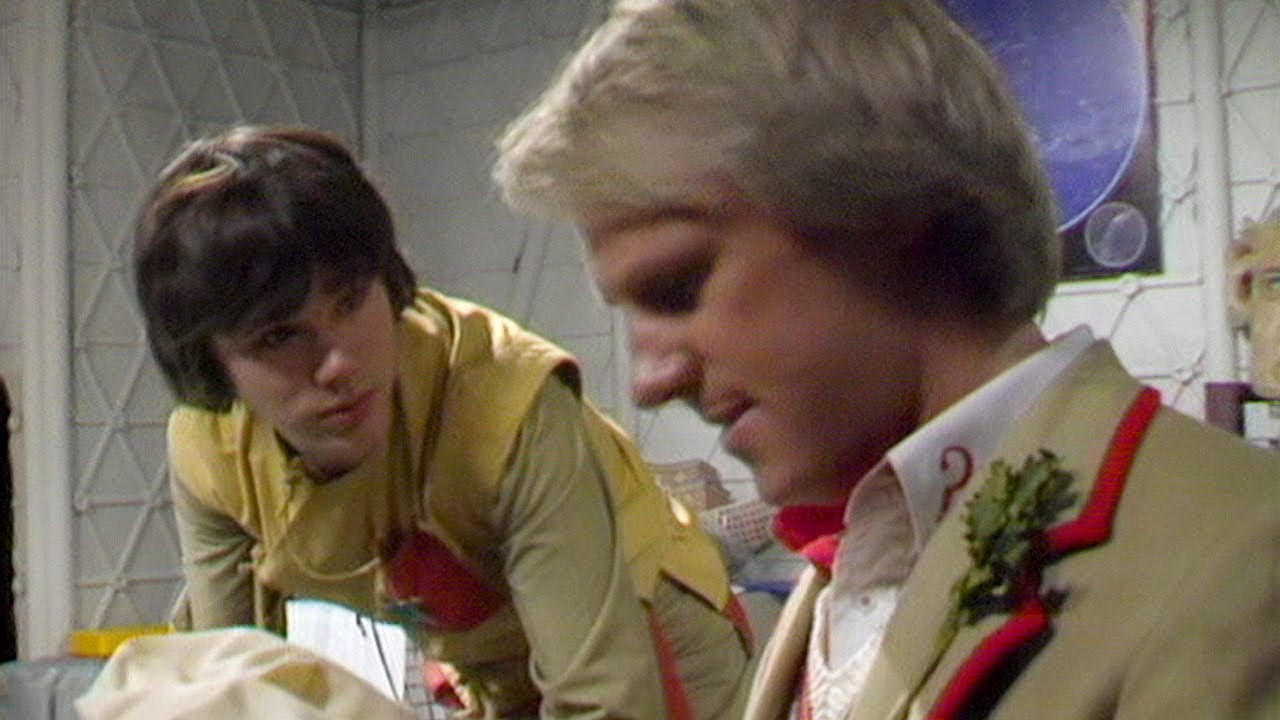 Ahh, kids, you know?
Ahh, kids, you know?
The complexities of family life are humorously highlighted in the Doctor’s interactions with his companions.
This endearing dynamic was further highlighted by moments like their trip to 1925, where Tegan was offered alcohol while Nyssa and Adric, like the Doctor himself, received orange juice, a subtle nod to their age difference. This larger TARDIS team, reminiscent of a family unit, was a welcome change, offering a richer and more complex interpersonal dynamic than the Doctor and single companion format that had been more common. It evoked the earlier days of Doctor Who with the First Doctor and his granddaughter Susan, and later Vicki, but with a distinctly more paternal and nuanced energy from the Fifth Doctor. His care and concern for his companions were palpable, balancing reprimands with praise, and consistently demonstrating his fierce protectiveness.
Fifth Doctor’s Expressions: The ’80s Sitcom Charm
Adding to the ’80s sitcom vibe were the Fifth Doctor’s expressive reactions. His surprised, shocked, and slightly overwhelmed facial expressions perfectly conveyed a sense of being in over his head, further solidifying the “single dad” analogy.
 I love this so much.
I love this so much.
A quintessential surprised expression from the Fifth Doctor, highlighting his endearing charm.
 He’s so cute!
He’s so cute!
Another charmingly expressive moment from the Fifth Doctor, showcasing his youthful energy.
Echoes in the Tenth Doctor: Davison’s Influence
The influence of Peter Davison’s Fifth Doctor on later incarnations, particularly David Tennant’s Tenth Doctor, is undeniable. From mannerisms like pushing back his coat to put hands in pockets, to using glasses for reading and tech, and the rapid shifts from lighthearted to serious, even threatening, when danger arose – these traits are clearly echoed in Tennant’s performance. The Fifth Doctor’s portrayal laid groundwork for future Doctors, demonstrating the lasting impact of Davison’s interpretation.
Regeneration Amnesia: A Shared Trait with the Thirteenth Doctor
Interestingly, the Fifth Doctor, much like Jodie Whittaker’s Thirteenth Doctor in modern Doctor Who, experienced post-regeneration amnesia. In “Castrovalva,” when asked “Who are you, stranger?” he replies, “That’s the strangest thing of all…I’m not entirely sure.” This shared experience of regeneration-induced identity confusion adds another layer of connection between these seemingly disparate Doctors across eras.
Memorable Villains: The Terileptils
Among the aliens encountered by the Fifth Doctor, the Terileptils stood out as visually striking and conceptually intriguing. In a series known for its imaginative alien creations, the Terileptils were a welcome reminder of the show’s capacity for unique and memorable antagonists. Their return in future stories or novels would be a welcome prospect.
 The Terileptle and the Doctor
The Terileptle and the Doctor
The Fifth Doctor confronts a Terileptil, a visually striking and memorable alien foe.
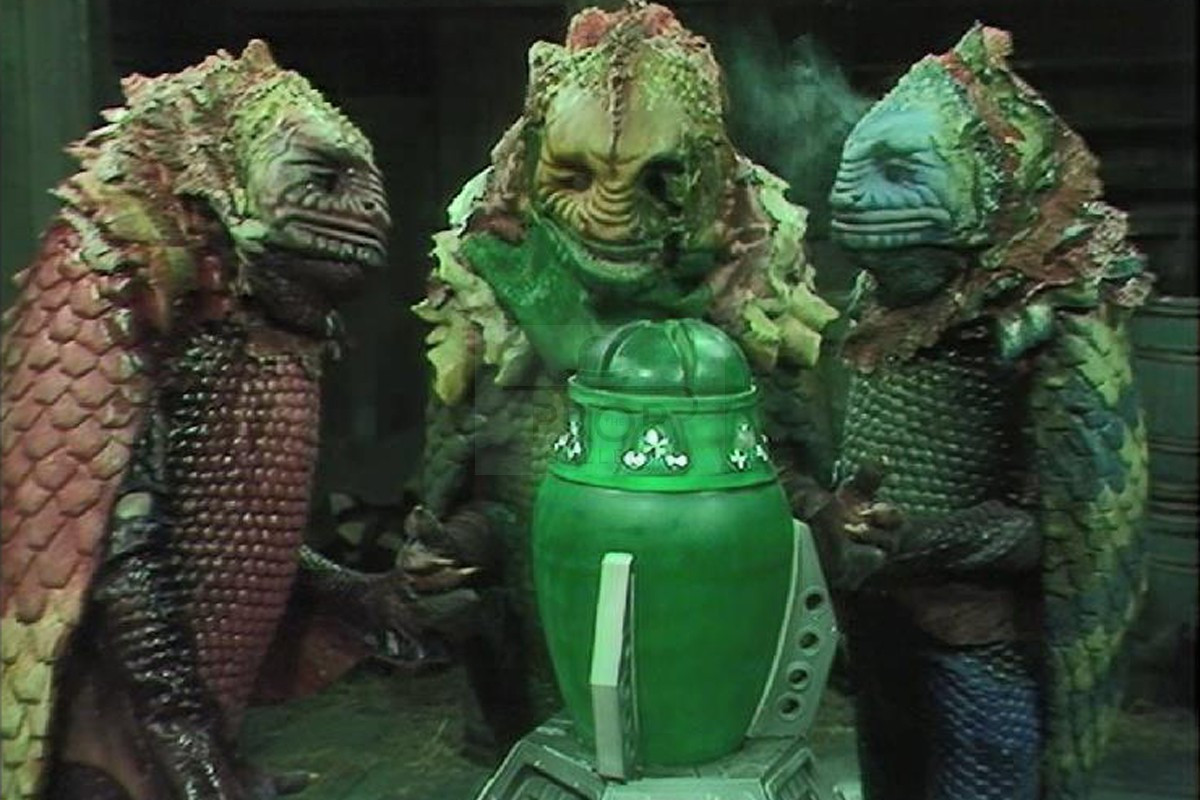 Ahhhh! See?!? They just look SO COOL.
Ahhhh! See?!? They just look SO COOL.
A close-up view emphasizing the Terileptils’ distinctive and impressive design.
The Terileptil plotline in “The Visitation” delved into themes of colonization and environmental stewardship, recurring themes throughout the Fifth Doctor’s era. The Terileptils, escaped convicts seeking to replace humanity on Earth, mirrored humanity’s own history of displacing indigenous populations. During their confrontation, the Doctor’s sonic screwdriver, a staple of his adventures, is destroyed by a Terileptil. The Doctor’s lament, “I feel like I’ve lost an old friend,” highlights the significance of this tool, despite its relatively limited use in classic Doctor Who.
The Sonic Screwdriver: A Tool of Last Resort in Classic Who
The destruction of the sonic screwdriver underscores a key difference between classic and modern Doctor Who. In the classic series, the sonic screwdriver was used sparingly, primarily for basic tasks like unlocking doors or opening panels. It lacked the ubiquitous scanning, weapon-jamming, and tech-hijacking capabilities it possesses in the modern era. Classic Doctor Who emphasized the Doctor’s intellect and wit as his primary tools, a refreshing contrast to the sonic screwdriver’s near-omnipresence in modern iterations. This limitation arguably made the Doctor’s problem-solving even more impressive, relying on his ingenuity rather than a technological crutch.
Nyssa’s increasing competence and brilliance were further highlighted when the Doctor tasked her with building a device to counter the Terileptil plague. Her success showcased her growing skills in technology and problem-solving, mirroring companions like Zoe and Romana who were intellectual equals to the Doctor. Classic Doctor Who often thrived when the Doctor was paired with companions who challenged and complemented his intellect, a dynamic less frequently seen in modern Doctor Who where companions are often contemporary humans from Earth.
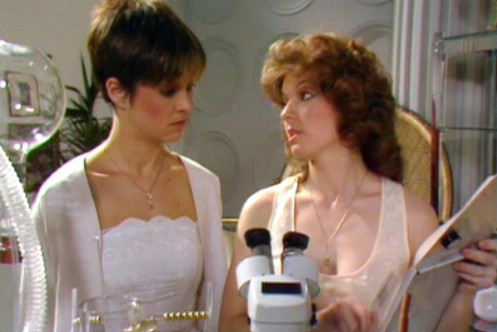 Tegan talks with Nyssa as she works in her lab in their room onboard the TARDIS.
Tegan talks with Nyssa as she works in her lab in their room onboard the TARDIS.
Nyssa’s scientific acumen is on display as she works in her TARDIS lab, observed by Tegan.
Beyond Earth: Diverse Companions and TARDIS Skills
Classic Doctor Who broadened the companion pool beyond contemporary Earth humans. Aliens, future humans, and individuals from other dimensions joined the Doctor’s travels, offering diverse perspectives and skill sets. Adric frequently piloted the TARDIS, and even Tegan, the “regular” Earth girl, learned to operate scanners, input coordinates, and perform basic flight maneuvers. Nyssa and Tegan even navigated the TARDIS to Castrovalva to save the newly regenerated Doctor. Turlough, upon joining the crew, also demonstrated TARDIS piloting skills due to his Trionian origins.
Turlough’s Contentious Introduction and the Black Guardian Saga
Turlough’s initial introduction was less than smooth. His recruitment by the Black Guardian, a cosmic entity seeking revenge on the Doctor, felt somewhat contrived. The Black Guardian’s plan to use a “douchie prep school student” as an assassin seemed disproportionately petty for such a powerful being. However, Mark Strickson’s portrayal of Turlough was compelling, capturing the character’s initial unpleasantness and subsequent growth.
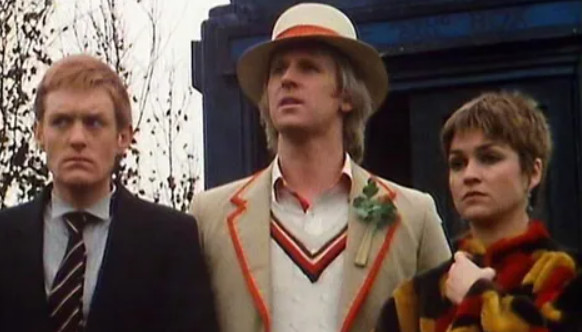 Turlough, the Doctor, and Tegan…and yes, he really isn’t *that* bad ;D.
Turlough, the Doctor, and Tegan…and yes, he really isn’t *that* bad ;D.
The TARDIS team with Turlough, showcasing his eventual integration into the group.
Despite initial reservations, Turlough’s character arc evolved, and his introduction episode also marked a significant moment: the second-to-last appearance of Brigadier Lethbridge-Stewart. The Brigadier’s presence served as a nostalgic link to the Third Doctor era and the UNIT family, a dynamic that resonated deeply and highlighted the desire for a similar UNIT-centric season in modern Doctor Who.
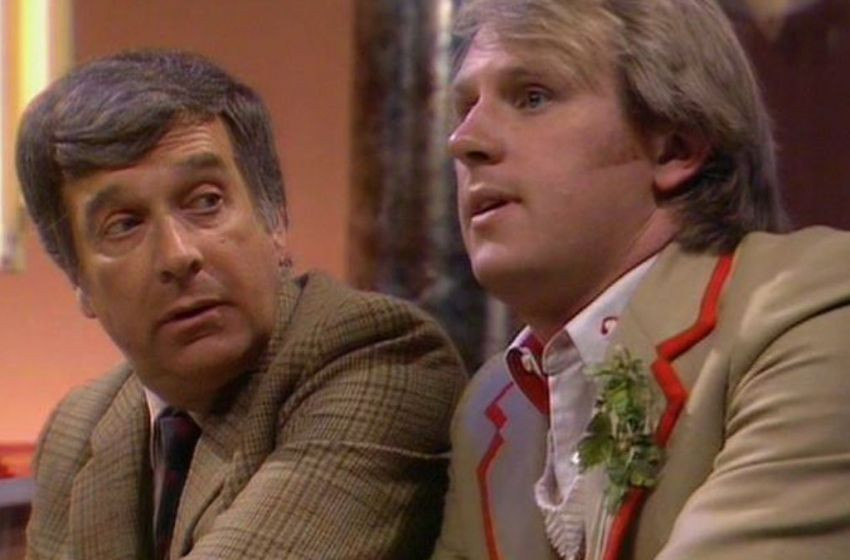 The Brigadier and the Doctor together again, for one last adventure.
The Brigadier and the Doctor together again, for one last adventure.
A poignant reunion: The Brigadier and the Fifth Doctor share one final adventure together.
The Brigadier made his final appearance in the 20th Anniversary Special, “The Five Doctors,” a celebratory episode that brought back multiple Doctors. The special was a joyous occasion, featuring Jon Pertwee’s Third Doctor and Patrick Troughton’s Second Doctor, with Richard Hurndall stepping in admirably as the First Doctor. Tom Baker declined to return, resulting in the use of “Shada” footage and even a wax dummy for promotional material, a testament to the creative solutions employed for this milestone episode.
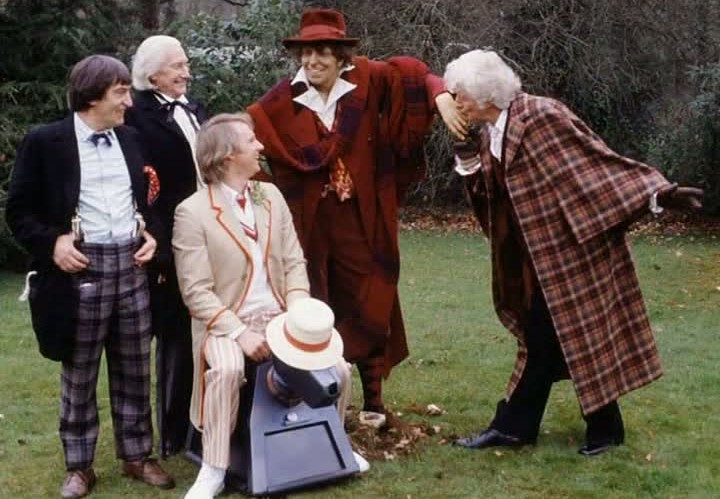 Jon Pertwee having fun with the fact that Tom Baker didn’t deign to return XD. I love, love, love Jon :).
Jon Pertwee having fun with the fact that Tom Baker didn’t deign to return XD. I love, love, love Jon :).
Jon Pertwee humorously acknowledges Tom Baker’s absence from “The Five Doctors” anniversary special.
The Mara: Exploring Hindu Symbolism and Existential Horror
Among the Fifth Doctor’s villains, the Mara stood out, particularly given its recent name-drop in the Fifteenth Doctor’s era. Drawing from Hindu mythology, the Mara represented delusion and despair. The serial “Kinda” explored themes of colonization through a 1980s lens, depicting well-intentioned but ultimately flawed attempts to understand an indigenous culture. The Kinda society, a matriarchal civilization led by Panna (wisdom) and Karuna (compassion), incorporated Hindu symbolism, including the Book of Jnana (wisdom).
The Mara storyline delved into existential horror as Tegan became psychically আক্রান্ত, experiencing terrifying mental intrusions. Panna’s description of the Mara, tied to the cyclical nature of civilizations and suffering, painted a vivid picture of a force feeding on despair and delusion. The resolution, defeating the Mara with mirrors, was a clever metaphor for confronting inner demons and delusions, as the Mara “cannot bear the sight of its own reflection.”
 The Doctor and the Kinda defeat the Mara.
The Doctor and the Kinda defeat the Mara.
The Fifth Doctor and the Kinda people collaborate to defeat the Mara, using mirrors as a symbolic weapon.
Descent into Darkness: Moral Ambiguity and Loss
While the Fifth Doctor’s era began with a light, sitcom-like tone, it gradually descended into darker territory, culminating in moral ambiguity and significant loss, foreshadowing the darker themes of modern Doctor Who. Recurring villains like the Cybermen, Omega, the Mara, the Black Guardian, the Master, and the Daleks contributed to this escalating darkness.
Adric’s death in “Earthshock” marked a turning point. He became the first classic Doctor Who companion to die, sacrificing himself to prevent a Cyberman ship from crashing into Earth and causing the dinosaur extinction. This unprecedented companion death was a shocking and painful moment, especially for viewers in 1982. The silent credits rolling over Adric’s shattered star badge amplified the tragedy. This impactful scene mirrored the emotional weight of companion departures in modern Doctor Who, like the Tenth Doctor losing Rose, but with even greater shock value due to its novelty in the classic series.
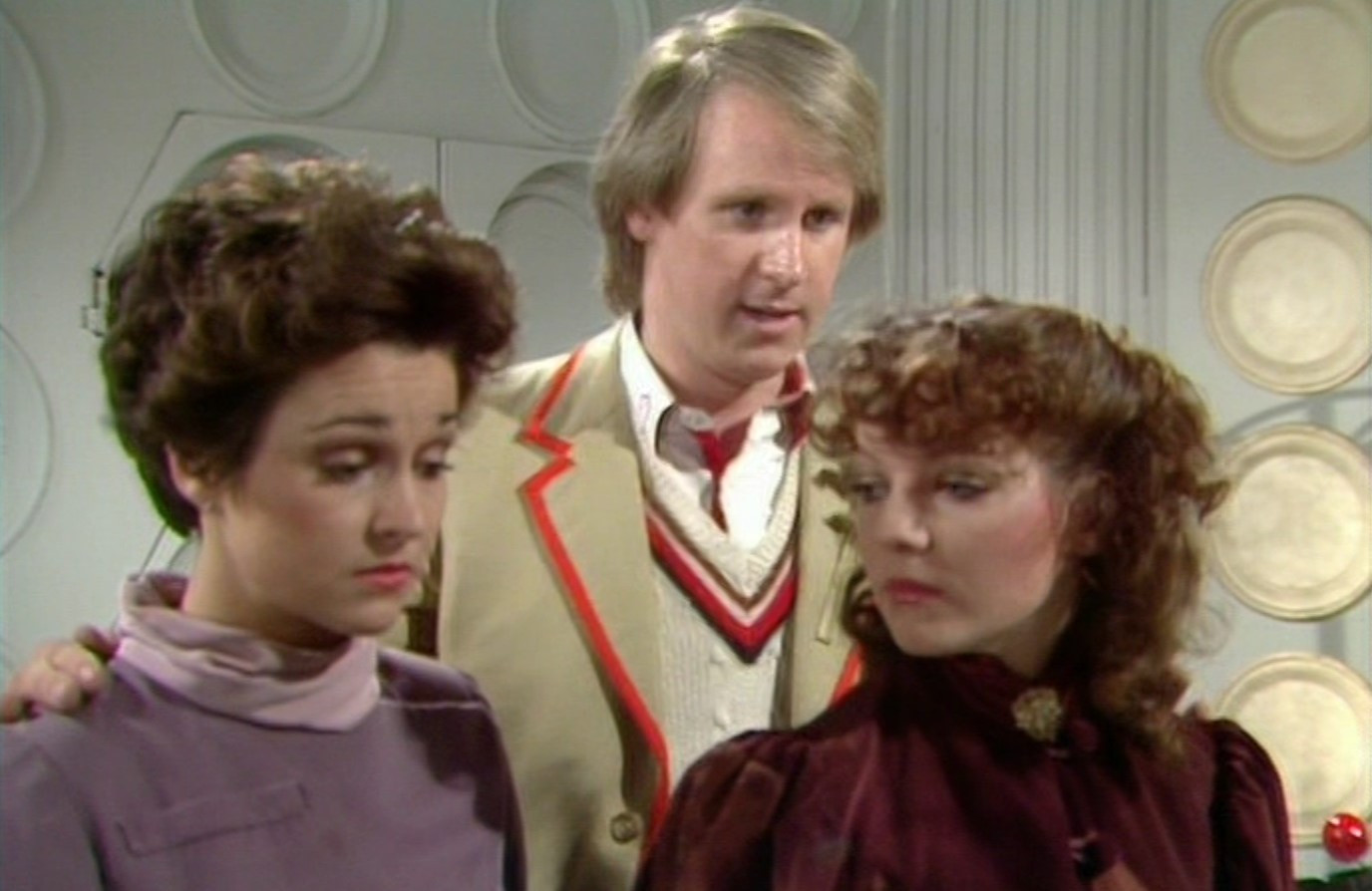 The Doctor does his best to console Tegan and Nyssa.
The Doctor does his best to console Tegan and Nyssa.
The Doctor attempts to comfort Tegan and Nyssa, grappling with the aftermath of Adric’s death.
The immediate episode following Adric’s death showcased the Doctor’s coping mechanism: burying grief and seeking distraction. This response, while perhaps understandable, highlighted a growing darkness within the Doctor’s persona.
 Nyssa and Tegan will travel with the Doctor for a long time…and I loved it! I loved their li’l TARDIS family so much :).
Nyssa and Tegan will travel with the Doctor for a long time…and I loved it! I loved their li’l TARDIS family so much :).
The enduring bond between the Doctor, Nyssa, and Tegan, a beloved TARDIS family.
Moral Crossroads: Davros, the Daleks, and the Master’s Demise
The darkness deepened in “Resurrection of the Daleks,” where the Doctor contemplated murdering Davros to prevent the Daleks’ resurgence. His willingness to consider such an act, coupled with his ruthless destruction of Daleks, showcased a stark departure from previous Doctors. Even more shocking was the Master’s death in “Planet of Fire.” Trapped in flames, the Master pleaded for mercy, but the Doctor, with the means to save him, chose to watch him burn to death. This act of calculated inaction was profoundly dark, raising questions about the Doctor’s moral boundaries and the influence of a changing, perhaps more cynical, era.
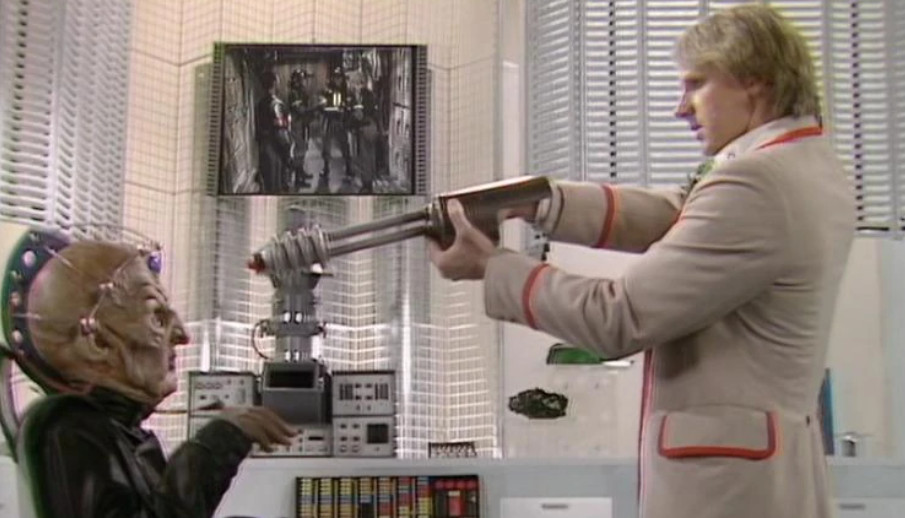 The Doctor prepares to murder Davros, as he’s been gunning down Daleks left and right.
The Doctor prepares to murder Davros, as he’s been gunning down Daleks left and right.
The Fifth Doctor, in a moment of moral conflict, contemplates killing Davros.
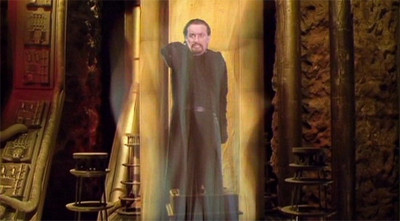 The Master demands, threatens, and then begs for his life as he burns alive with the Doctor looking on.
The Master demands, threatens, and then begs for his life as he burns alive with the Doctor looking on.
The Master’s agonizing final moments as the Doctor watches, a scene of profound darkness.
This darker shift in tone might reflect the cultural landscape of the 1980s, with the rise of action heroes and grittier narratives. Parallels to Star Wars emerged in the Doctor’s increasingly physical interactions with the TARDIS console, mirroring the Millennium Falcon’s often temperamental nature. The introduction of Peri Brown, an American companion from Baltimore, after Nyssa and Tegan’s departures, could also be interpreted as an attempt to broaden the show’s appeal, although this is speculative.
Final Thoughts: A Warm and Endearing Doctor
Despite the darker undertones that emerged towards the end, the Fifth Doctor’s core essence remained warm and empathetic. His joy, his quirky habits like tossing a cricket ball or flipping a coin for decisions, and his endearing expressions made him instantly lovable. Even his cricket game in 1925, while hilariously confusing to me, added to his charm.
The Doctor and Peri, a new companion dynamic as the TARDIS journey continues.
Peter Davison’s Fifth Doctor, despite my initial hesitation after Tom Baker’s iconic run, quickly won me over. The TARDIS family of the Doctor, Nyssa, and Tegan, alongside Adric and Turlough, became one of my all-time favorite Doctor Who teams. The Fifth Doctor’s era is a testament to the enduring appeal and adaptability of Doctor Who, seamlessly blending lighthearted moments with darker themes and paving the way for future incarnations of the Time Lord.
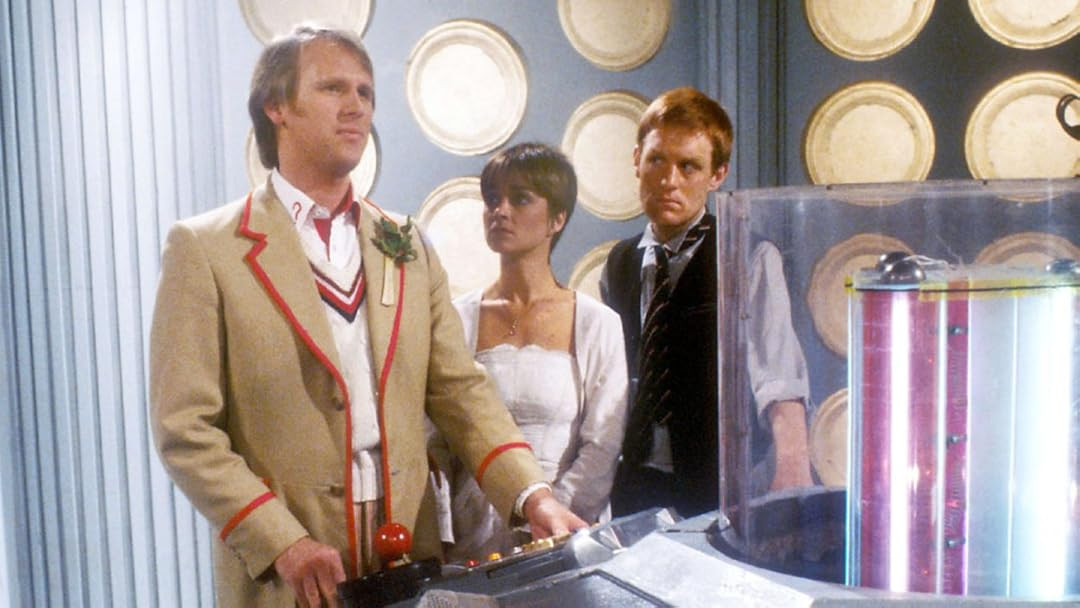 The Doctor, Tegan, and Turlough at the TARDIS console – whether with Adric, Turlough, or on their own, I could never tire of watching Nyssa and Tegan with the Doctor :).
The Doctor, Tegan, and Turlough at the TARDIS console – whether with Adric, Turlough, or on their own, I could never tire of watching Nyssa and Tegan with the Doctor :).
The Fifth Doctor, Tegan, and Turlough at the TARDIS console, a beloved trio from a memorable era.
Explore More Doctor Regenerations:
- Impressions of the First Doctor
- Impressions of the Second Doctor
- Impressions of the Third Doctor
- Impressions of the Fourth Doctor
